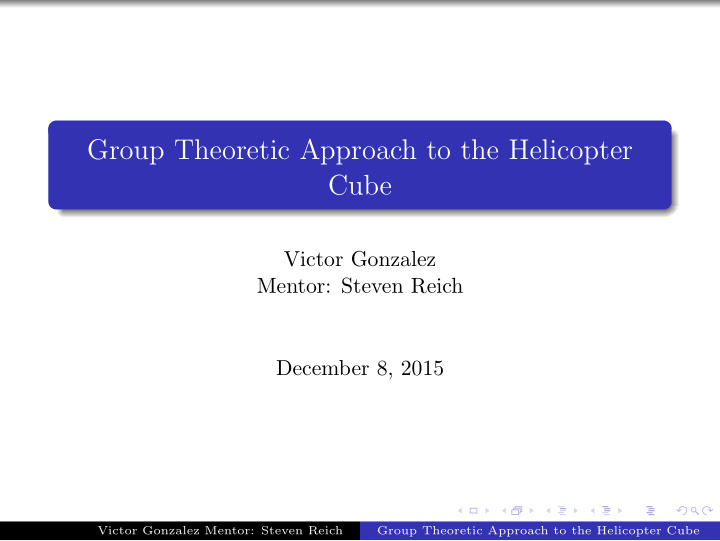



Group Theoretic Approach to the Helicopter Cube Victor Gonzalez Mentor: Steven Reich December 8, 2015 Victor Gonzalez Mentor: Steven Reich Group Theoretic Approach to the Helicopter Cube
Rubik’s Cube Figure: Picture from thinkgeek.com The movements of the Rubik’s Cube form a group! The group is a subgroup of the symmetric group S 48 . The size of the group is 43,252,003,274,489,856,000. Victor Gonzalez Mentor: Steven Reich Group Theoretic Approach to the Helicopter Cube
Helicopter Cube For this project, we wanted to work with the Helicopter cube. Figure: Photo found on kostkirubika.pl Where we study this puzzle similarly to the Rubik’s Cube. Victor Gonzalez Mentor: Steven Reich Group Theoretic Approach to the Helicopter Cube
Generator Example Moving one of the edges is one of the known generators 3 8 3 7 3 4 33 6 2 2 1 6 5 7 8 3 4 One example would be Generator = (1 , 33)(2 , 34)(5 , 37)(6 , 38)(9 , 26); The collection of all these edge moves do not generate the whole group. Victor Gonzalez Mentor: Steven Reich Group Theoretic Approach to the Helicopter Cube
GAP We used a program, GAP, where we inputted all the possible actions that generate the whole the group. We added all the actions on the cube into GAP. We can ask GAP questions about the group, such as the size, orbits, or if a certain action is in the group. Victor Gonzalez Mentor: Steven Reich Group Theoretic Approach to the Helicopter Cube
The Extra Moves There exists a strange move With just the edge moves, the group size is 11,848,661,611,315,200,000. Compared to the Rubik’s Cube, which is 43,252,003,274,489,856,000. With the new moves, the group size goes up to 27,355,520,396,546,388,222,227,251,200,000! Victor Gonzalez Mentor: Steven Reich Group Theoretic Approach to the Helicopter Cube
Orbits There are two main orbits that make up the Helicopter Cube, similar to the Rubik’s Cube. The corner pieces fall in one orbit The center pieces fall into a different orbit. Victor Gonzalez Mentor: Steven Reich Group Theoretic Approach to the Helicopter Cube
The Normal Subgroups We can think of some of the normal subgroups that make up the whole group. Such a group would keep the positions the same, but change the orientation of the pieces. Such a move would give us: Victor Gonzalez Mentor: Steven Reich Group Theoretic Approach to the Helicopter Cube
Generators We considered the possibility of generating an edge move with a combination of other movements. Such a combination would create: Finding such a combination would allow us to conclude that there are fewer than 24 generators of the whole group. In fact, with the help of GAP, we found that there are 14 generators. Victor Gonzalez Mentor: Steven Reich Group Theoretic Approach to the Helicopter Cube
Conclusion The Rubik’s Cube group and the Helicopter Cube group are similar in many ways, but the Helicopter Cube’s unique movements make the group a little more complicated. We can use GAP to learn more about, not only the Helicopter Cube, but other puzzles as well. Victor Gonzalez Mentor: Steven Reich Group Theoretic Approach to the Helicopter Cube
Recommend
More recommend